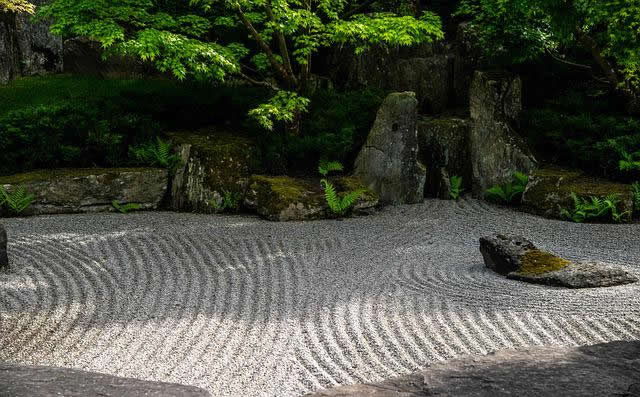先日から「The meaning behind the Japanese Zen garden -「日本の禅庭に込められた意味」を読んでいます。

・「日本の禅庭に込められた意味」(1)
・「日本の禅庭に込められた意味」(2)
・「日本の禅庭に込められた意味」(3)
・「日本の禅庭に込められた意味」(4)
・「日本の禅庭に込められた意味」(5)
Another key concept in Zen gardens is the abundance of empty space – pristine and uncluttered – a reflection of how your mind should be when you’re meditating.
禅庭のもうひとつの重要なコンセプトは、何もない素朴で整頓された空間、つまり瞑想中の心のあり方を反映していることだ。
pristine「素朴な、清純な、汚れていない、きれいな、初期の、原始時代の」。
In the West, we are uncomfortable with an empty space, just as we are with silence.
西洋では沈黙と同じく、何もない空間は居心地が悪いとされている。
We feel compelled to fill both.
私たちは、その両方を満たさねばならないと感じている。
be compelled to「やむを得ず~する、~せざるを得ない、仕方なしに~する」。
In Zen, space is important, beautiful even, as demonstrated by the two concepts of ma (interval or space) and yohaku no bi (the beauty of emptiness).
禅では「間」と「余白の美」という二つの概念で示されるように、空間は重要であり、美しくもある。
According to Mira Locher, architect, educator and author of two books about Shunmyō Masuno (Zen Garden Design, 2020,and Zen Gardens – The Complete Works Of Shunmyō Masuno,2012):
建築家、教育者であり、枡野俊明に関する2冊の本の著者であるミラ・ロッチャー曰く
“The concept of ma, implies the existence of a boundary, something that defines the interval or space (for example, two columns).
「“間”という概念は、境界の存在、つまり間隔や空間を規定するもの(例えば2本の柱)の存在を意味します。
In the West, we tend to consider the boundary object(s) ‘positive’ and the space ‘negative’.
欧米では、境界の物体を“ポジティブ”、空間を“ネガティブ”と考える傾向があります。
However, in a Zen garden, the space (ma) is understood as a positive element, and the garden designer uses the boundary objects to shape it…
しかし禅庭では、空間(間)をポジティブな要素として理解し、庭師は境界のオブジェクトを使ってそれを形づくる・・・
it is an important element within the garden.”
それは庭の中の重要な要素です。」
「西洋では何もない空間は居心地が悪いとされる」これは知らなかったです。
確かに壁紙も家具もカーテンも装飾的な物が多いですよね。
飾る事が豊かさを表すような・・・その逆の引き算の美、何もない空間の豊かさという概念は一般的ではないのかも。
非常に異質で、だからこそ興味を惹かれる、それが禅の世界なのかもしれませんね。
理由は単純明快!「少ないコストでしっかり楽しく学べるから」。
私自身の経験(高機能でビックリ)をびっしり書いていますので、良かったら読んでみてください。
下のバナーからどうぞ!






